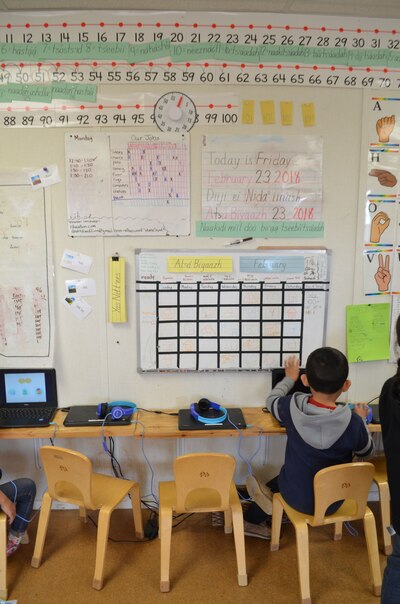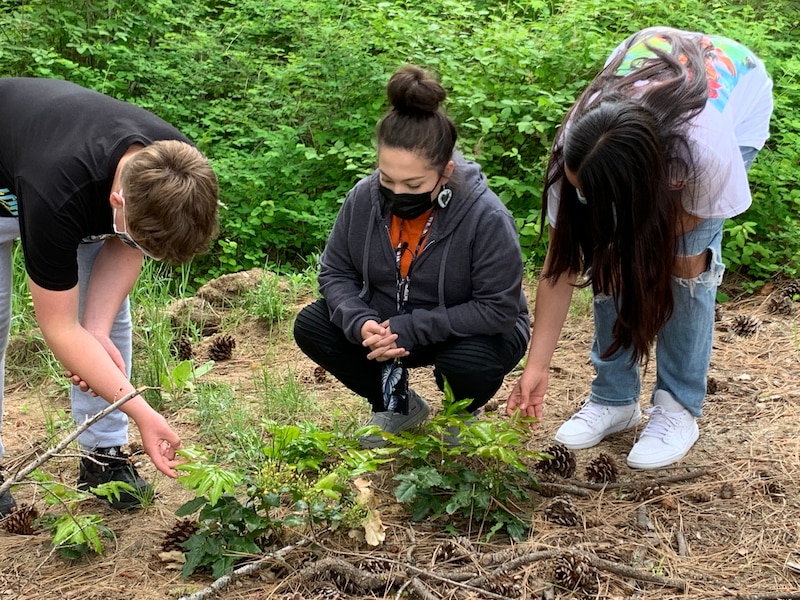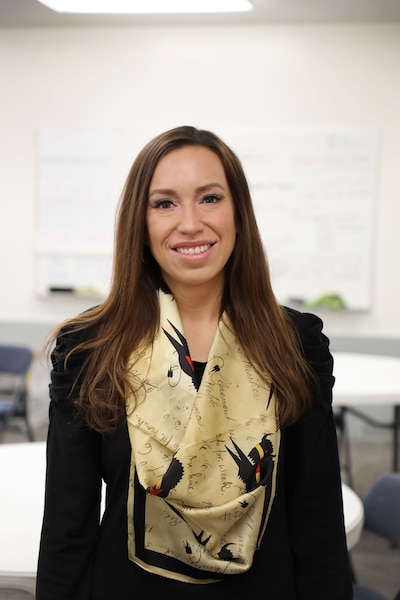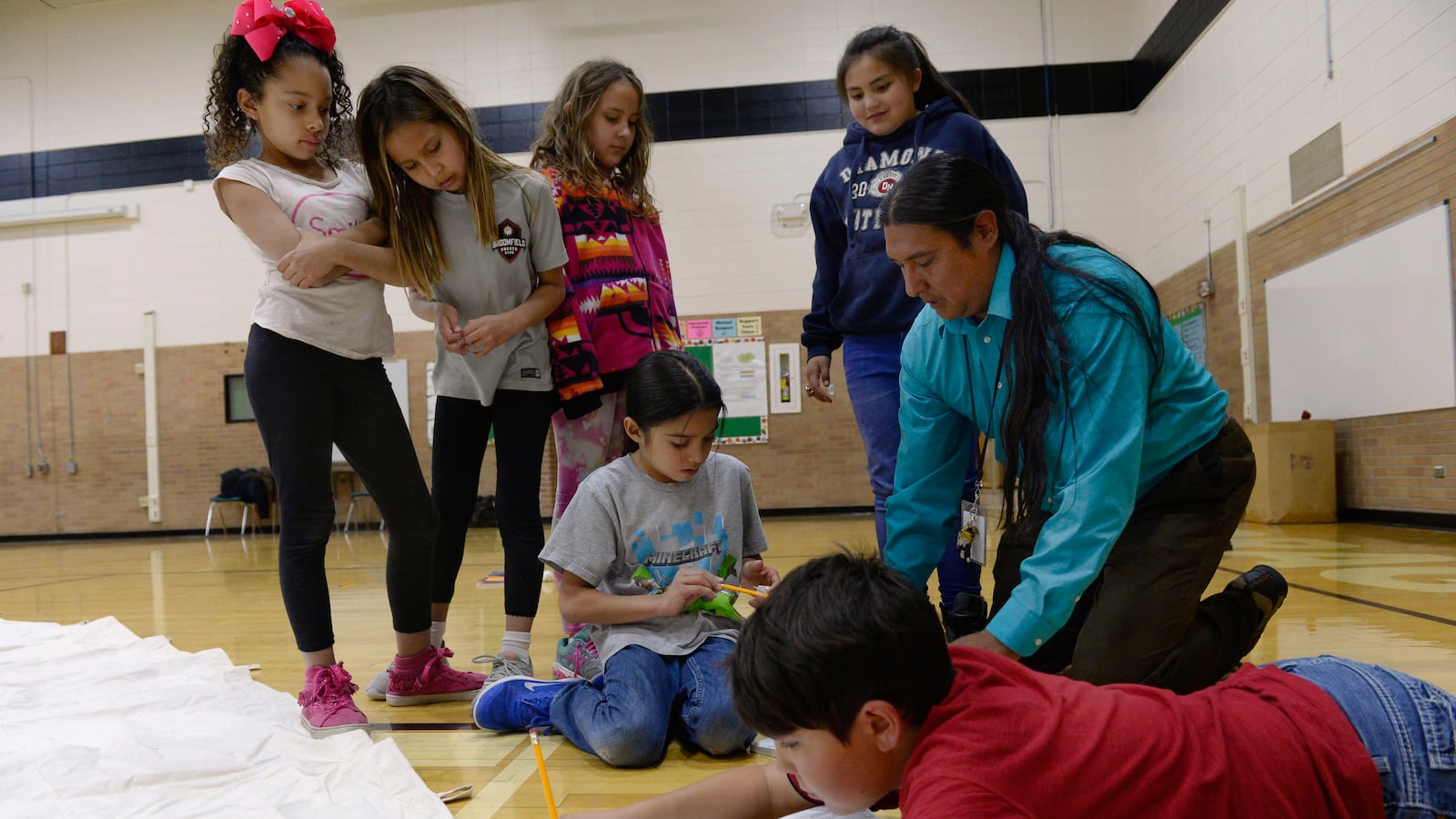When Jaylyn Suppah was a high school student, she had a lot of questions for her civics teacher.
Why were their lessons on Native Americans about tribes from the Midwest, with no mention of regional tribes like hers, the Warm Springs, Wasco, Shoshone-Bannock, and Yakama? Why did the textbook only spend a few pages on their history? And why were critical topics, like the forced assimilation of Native American children at U.S. boarding schools, missing?
Arguing with her teacher, Suppah recalls, got her kicked out of class. The experience stuck with Suppah, who advocated for an Oregon law over a decade later that now requires public schools to teach from a fuller, more accurate history of the Native American experience.
Changes are coming: The state developed some lessons and has provided tribes with funding to develop their own specific materials. Suppah’s grandmother has even contributed to the curriculum her tribe is creating, giving Suppah hope that her own children won’t have to fight to see their languages and traditions represented at school.
“I just would like them to have a more inclusive, truthful experience as far as it comes to Indigenous perspectives and how our story is told,” she said.

Efforts like this are underway across the country, as momentum builds to improve how U.S. schools teach American history — including the more painful parts of it — and better recognize the contributions of Native Americans.
But tribes and school officials are up against a series of challenges. Many tribal nations were hit especially hard by the pandemic and are recovering from great loss. Many states don’t spend much, or anything, to help develop tribally specific curriculum or to train teachers.
And some educators worry that their efforts to teach a more accurate version of U.S. history, including about massacres of Native Americans and federal policies that limited their rights, could run up against efforts to restrict educators from teaching about the ways in which racism is embedded in the country’s policies and laws.
“There is the fear of doing it because of the backlash,” said Deborah Dennison, who heads San Carlos Unified schools in Arizona, where nearly all of her students are members of the San Carlos Apache tribe. Her state passed a law this month banning educators from teaching about who bears responsibility for historic acts of racism. “To me, it’s more important now than ever.”
More states are adding, or discussing, Native American curriculum
The push to improve what students learn about Native Americans at school has existed for decades, but recent advocacy by tribes and Native American educators has led several states to add requirements or expand their curriculum.
The latest state to do so, North Dakota, passed a law earlier this year that requires schools to teach Native American history, starting with the upcoming school year. About 10% of the state’s students are Native American.
“Something like this has been long-awaited, I think, especially by our parents and some of our educators,” said Lucy Fredericks, who directs North Dakota’s office of Indian and multicultural education.
This summer, Fredericks has been busy fielding questions from schools and pointing educators to resources, including a series of video interviews with tribal elders. But the state isn’t developing specific curriculum for schools, or paying tribes to come up with their own materials, which has left some educators scrambling.
“We do hear that a lot,” said Diana Cournoyer, the executive director of the National Indian Education Association, which is paying staffers to help gather and evaluate curriculum materials in North Dakota. “They struggle because there’s not necessarily curriculum established to teach that history or that culture.”
Similarly, Connecticut lawmakers passed a new requirement this year that schools have to teach Native American studies, with a focus on Connecticut tribes, starting in 2023. (It passed despite some concerns from teachers unions and then-Education Commissioner Miguel Cardona, who worried it didn’t come with funding and could overwhelm schools still working to adopt other new requirements, including lessons on African American and Latino studies.)
The state plans to develop a model curriculum with the help of tribes and teachers, an education department spokesperson said.
In Minnesota, though, a proposal that would have required schools to teach Indigenous history and culture failed to pass this year. It was a blow for Ramona Kitto Stately, who chairs the Minnesota Indian Education Association and oversees K-12 education work at the nonprofit We Are Still Here Minnesota.
She had hoped it would lead to better teacher training and more authentic lessons in schools. But it had been a year of racial tension in the state, she noted, including the murder of George Floyd in Minneapolis and the toppling of a Christopher Columbus statue outside the state Capitol by protestors. The state also saw heated debates over critical race theory as it undertook a periodic review of social studies standards, which are slated to include more about Minnesota’s tribes and more of the Native American perspective.
“All of those things came together and it just didn’t happen,” she said.
Still, Minnesota tribes, educators, and Native-led organizations are working together to review materials that could be added to a central resource hub for teachers.
“I think there is a movement,” she said. “We bring all of these elements together, and we’re more focused, we’re more powerful.”
But even in places where these requirements have long been enshrined in state law, educators are watching to see if the debates over how racism and bias are taught in schools will spill over into their classrooms this year.
In Montana — which became the first state to require Native American studies for all students in 1999 — the schools superintendent wrote a blog post in May saying that critical race theory had no place in the state’s classrooms and directed parents to pay attention to their children’s lessons, and “speak up if you are concerned.” The state’s attorney general later issued a legal opinion saying educators can’t give assignments acknowledging that racial privilege exists.
Some Montana educators have said they would not let that affect how they taught about Native Americans. “We’re not shying away from conversations around how policies have impacted groups of people over time,” one school leader in Bozeman said. Still, it’s left some educators wary.
“You have to be really careful,” said Jordann Lankford, who helps educators in Great Falls Public Schools incorporate Native history and culture into their lessons. “All we can do is gather these varied voices and also gather more primary source documents, present our kids the evidence, and teach them how to think critically for themselves.”
Some schools and students have seen meaningful shifts
Though there’s been progress, many Native American students, who make up about 1% of U.S. students, or just under half a million, have little exposure to lessons about their history and culture at school. A recent survey of 27 states where many federally recognized tribes live found that only 11 required public schools to teach about Native Americans in at least some grade levels.
A nationally representative federal survey of more than 13,000 American Indian and Alaska Native students, released this spring, found that many elementary school students had teachers who never or rarely incorporated Indigenous culture or history into their language arts lessons.
Laws don’t immediately change those dynamics, as Washington illustrates. There, a 2005 law encouraged school districts to teach about the state’s tribes using a free curriculum called Since Time Immemorial that the state and tribes worked on together. But few districts chose to teach it.
A decade later, schools were required to use the curriculum or teach other tribally specific lessons. In 2018, the state went further, requiring teachers in training to learn about the materials.
Plenty of schools still haven’t started, advocates acknowledge. But Jennifer LeBret, who helped develop curriculum for the Spokane Tribe of Indians, is particularly hopeful about the impact of training teachers before they reach their first classrooms.
“They’ll at least have a taste of what they should be teaching and how to teach it and where to find the resources,” said LeBret, who has taught some of those classes.
For the students and families who have gotten to see these changes in action, it can be a powerful experience.

In Washington’s Wellpinit School District, which incorporates some of the Spokane curriculum, 12-year-old Isaac Park is learning Salish, one of the Spokane languages, and he learned about the menthol-flavored root that members of his tribe traditionally picked to soothe sore throats.
“We get to learn about what happened a long time ago, the stuff they had to go through when they were starving,” he said. “It feels like history, but the cool part is that there are still verbal stories that carry it on, so we know that it’s true.”
When school was remote during the pandemic, his mother, Teea McCoy, learned more about her tribe’s history alongside her son. That included lessons about Indigenous boarding schools, where many children died or were abused, which sparked her son’s interest in watching video interviews with his great-great-great grandmother about the local boarding school she attended.
“They’ll know more than I ever knew,” McCoy said. “Me, growing up, my history was all Christopher Columbus.”
And as schools work to recover from the pandemic, school leaders say culturally responsive education like this will be especially important for re-engaging students.

In Montana, which has long served as a model for teaching about Native Americans, Lankford sees students respond to lessons that connect history to students’ communities. One history and science unit she worked on looks at the digestive system and how the removal of tribes’ traditional food systems contributed to high rates of Type 2 diabetes on reservations. Another focuses on the Dawes Act, which allowed the U.S. government to break up tribal lands. It gives students a new way of understanding why many Montana reservations have high poverty rates.
“When you incorporate the historical concepts, and the legality surrounding that, and the federal policies surrounding that, it really puts things into perspective,” she said. “You can really see it on their faces when they get it.”
In Arizona, Dennison has long seen the connection between incorporating students’ traditions and culture at school and meeting their social and emotional needs. Even before the pandemic, her district had started an Apache language immersion program and drumming group in an effort to boost student pride.
This summer, the district piloted a new high school biology unit that teaches students about foods and medicines traditionally important to their tribe. But the district is also bolstering its counseling program to help the many students and staff who lost loved ones during the pandemic. That includes Dennison, whose husband died of COVID earlier this year.
“It’s about the system meeting the needs,” she said, “And they’re not just all academic needs. It’s a lot more than that.”


